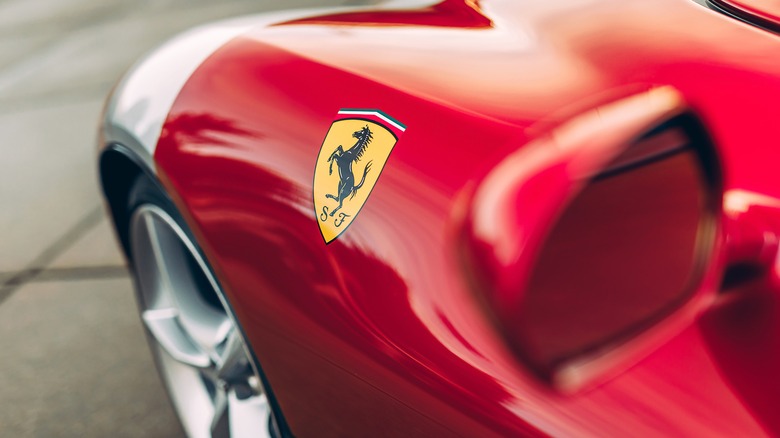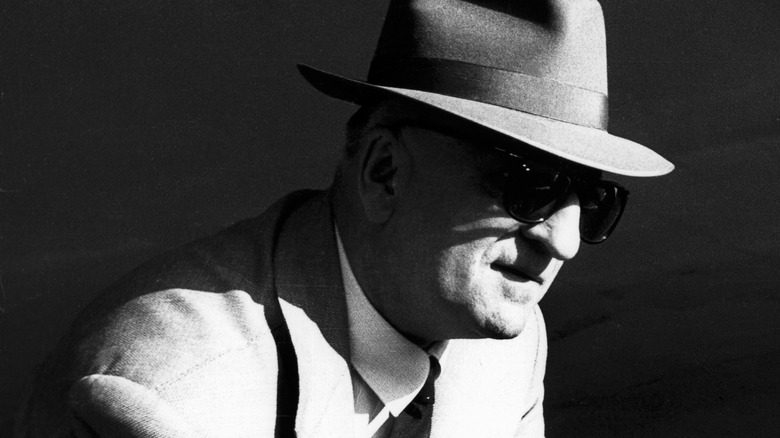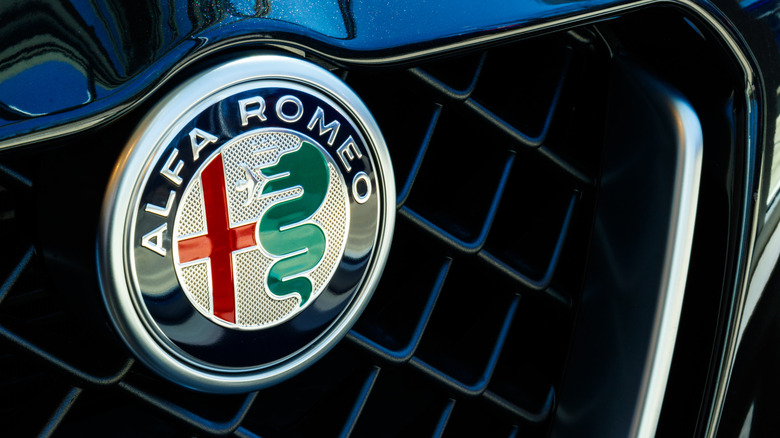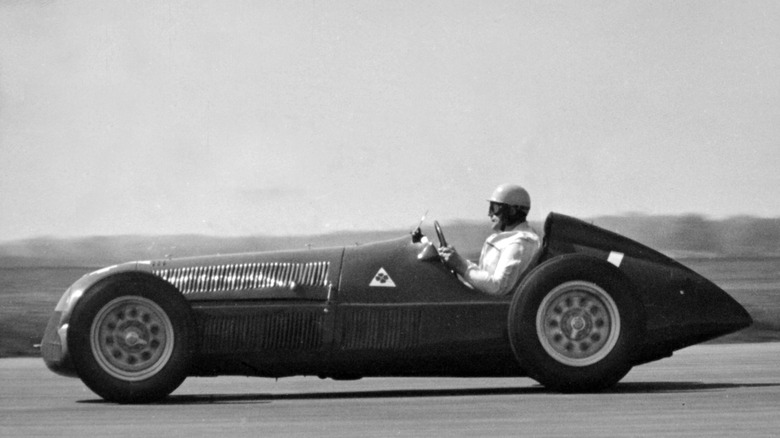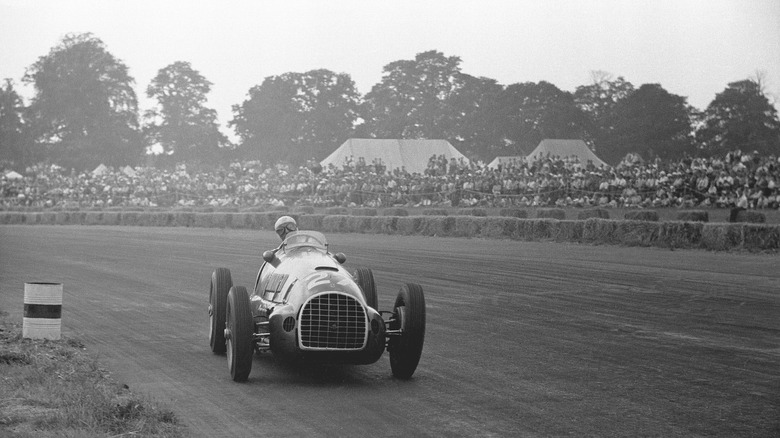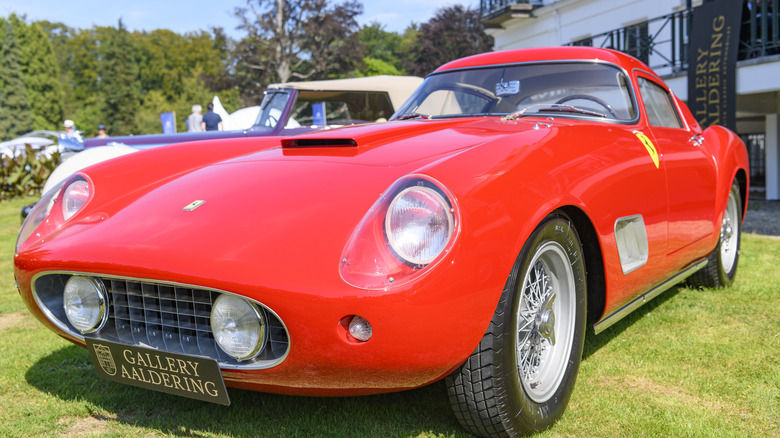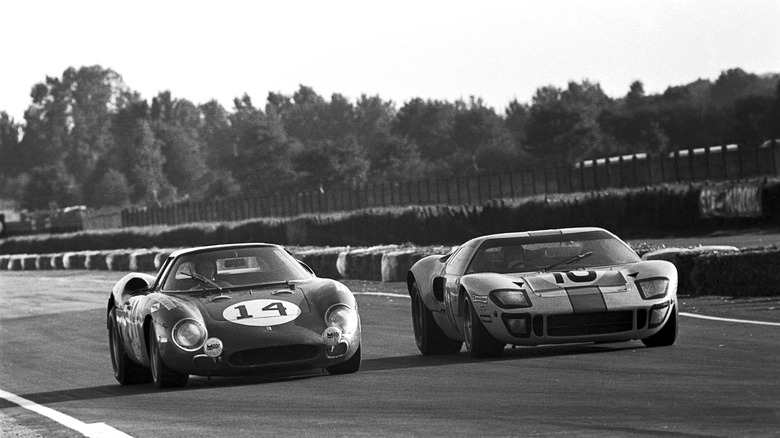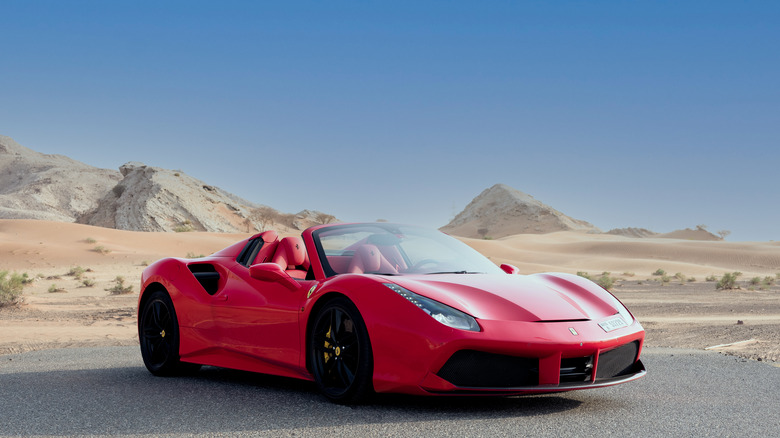How Ferrari Became A Car Manufacturer
Ferrari is one of the best-known brands of any kind in the world. It's gotten to the point where the iconic Italian brand has become so well known that it has led to many people erroneously referring to any high-end sports car — especially red ones — as Ferraris.
Ferrari has in a lot of ways transcended cars and become a lifestyle brand associated with the rich and successful, so it may come as a surprise to learn that the brand's founder, Enzo Ferrari, was initially resistant to the idea of producing road cars. Ferrari made a name for himself in the world of racing, and that was all he cared about: building fast, winning racecars (via Rosso Automobili).
Ferrari started his career as a driver and transitioned into running his own, namesake team, Scuderia Ferrari. The team still competes in Formula 1 to this day and it's one of the most popular and successful teams in history, with legions of rabid fans.
Enzo Ferrari became enamored with racing from the first time he saw a race
When Enzo Ferrari first saw a race car in action, they were still relatively new in every conceivable way. His father had taken the 10-year-old Ferrari to a race in Bologna, Italy, not too far from the town of Modena where he was born (via Biography). According to the National Museum of American History, automobiles must have tapped into a primitive part of the human brain, because almost from the second they were invented daring drivers were trying to see who could drive the fastest, as well as those trying to build the fastest cars. That caused an international rivalry between American and European manufacturers. Ferrari himself would become a major player in this rivalry, but that was decades down the road.
Until that day in Bologna, the young Ferrari had aspirations of becoming an opera singer, but seeing a race shifted his focus towards automobiles — specifically, toward racing them, something generations of race fans are thankful for. However, Ferrari still faced some hurdles before he could make a name for himself in racing. His father and brother died in 1916, both of them victims of the flu. World War I started raging and dragged almost all of Europe into the fray. According to Insider, Ferrari was drafted into the Italian military in 1917. One of the nastiest battles Ferrari faced during the war didn't even happen on the battlefield. He had to deal with a case of the flu, the same disease that killed his father and brother.
After the war, Ferrari had trouble finding a job in the auto industry
When World War I came to an end, many countries, including Italy, saw a wave of veterans hoping to enter the workforce. Enzo Ferrari was one such veteran, and given the fascination he had with automobiles, he decided to try getting work in the auto industry. However, according to Insider, with so many other veterans also looking for work, Ferrari had trouble getting a job and was turned away by Italian manufacturer Fiat. Of course, the company had no way of knowing that they were turning away a man who would go on to start a massively successful racing team and car company of his own, though Fiat would one day find its way back into the Ferrari story.
Undeterred, Ferrari managed to get his foot in the door at Costruzioni Meccaniche Nazionali, or CMN (via Biography). Ferrari worked for the CMN racing team and got his first opportunity to jump into the cockpit of a race car. His time there only lasted one year before he left and joined Alfa Romeo. The company had been around for a few years under various guises but they had stopped making cars during the war, per Museo Storico Alfa Romeo. Shortly after Ferrari joined Alfa Romeo as a driver, the factory team became one of the most successful in the world.
Ferrari and the 'Prancing Horse'
According to Biography, Ferrari was an up-and-coming driver for Alfa Romeo in 1923 when he met the family of an Italian fighter pilot who had been killed in World War I. The pilot, Francesco Baracca, was an ace who took down 34 enemy aircraft during the war (via First World War). Baracca himself was shot down and killed in 1918. Baracca used an image of a horse on his plane, and his family recommended to Ferrari that he start using the symbol on his race cars for good luck. Ferrari obliged and started using the "Prancing Horse" on his cars.
In 1929, after years of driving and winning races for Alfa Romeo, Ferrari started his own team, Scuderia Ferrari. Scuderia is the Italian word for stable (like where horses are kept), and while the team had its own drivers and support staff, they primarily competed in Alfa Romeos.
Ferrari started designing his own cars
Scuderia Ferrari continued running Alfa Romeos through the 1930s. The team also ran its first car designed by Ferrari himself, the Alfa 158 (per Automotive Hall of Fame). The car was a massive success, and at the first Formula 1 World Championship race in 1950, three of the four 158s that entered the race came home in first, second, and third place. This happened 13 years after the car made its debut.
Ferrari's stock was rising in the racing world, and Alfa Romeo convinced him to shutter the original incarnation of Scuderia Ferrari and run the Alfa factory team, known as Alda Corse (via Insider). This only lasted a few years, and perhaps realizing that he had the design and technical acumen to find success, Ferrari struck out on his own. He founded a company called Auto Avio Costruzioni, a name that was selected because Ferrari had agreed with his former employer, Alfa Romeo, that he would not use his name. AAC's first car was released in 1940 and it was called the AAC 815. Of course, 1940s Europe sets off alarm bells in any history buff's head, and Ferrari's new outfit was not immune to the war. Racing took a backseat, and according to Biography, the company moved to its modern hometown of Maranello and made grinding machines in support of the war effort.
The first Ferrari debuts
By 1947, with some parts of Europe still smoldering from years of war, it was time to return to racing. By then, Ferrari's agreement not to use his name had lapsed, and so the first race car badged as a Ferrari — the 125 S — found its way to the starting grid (via Biography). It didn't take long for the first Ferrari to take a checkered flag, doing so on home soil at the 1947 Rome Grand Prix.
The 125 S had a hand in announcing Ferrari's arrival on the racing scene with wins at some of the world's biggest races, including victories at the 24 Hours of Le Mans and the British Grand Prix. The cars that followed built upon the 125's success. Ferrari took home their first two Formula 1 World Championships with the Ferrari 500 in 1952 and 1953, with the legendary Italian driver Alberto Ascari behind the wheel both years.
Ferrari's cars bearing the iconic rosso corsa, or racing red, used to identify Italian race cars, were garnering a lot of attention, and that made lots of people — even non-racing drivers — want a Ferrari of their own.
Ferrari was initially resistant to the idea of selling road cars
With an increasing demand for street-legal versions of Ferrari's race cars, it seemed that giving the people what they wanted would be a no-brainer. However, the man himself, Enzo Ferrari, was initially against the idea of producing road cars.
According to Insider, one of the first people to approach Ferrari with the idea was a driver named Luigi Chinetti. According to Rosso Automobili, Chinetti had competed in endurance races like Le Mans and the 24 Hours of Spa-Francorchamps, winning them both multiple times. During World War II, he had left Italy for the United States, and by the late 40s was a naturalized U.S. Citizen.
Chinetti knew Ferrari from when they were both working for Alfa Romeo and he brought up the idea of Ferrari producing road cars. Ferrari was reluctant because he was only interested in winning races. They developed a plan that started with first selling their race cars to privateers, or independent teams and drivers who were looking to race, but didn't build their own cars. Eventually, they transitioned to producing road cars, and the revenue they brought in would go back into the racing side of the operation. By the 1950s, Chiinetti opened the first Ferrari showroom in the United States. It was originally in Manhattan, but was eventually moved outside the city to Greenwich, Connecticut, and is still in operation today.
Ferrari attracted a lot of attention and even a rivalry with Ford
Ferrari's success on track — which has been more or less uninterrupted for more than 70 years — was what originally stirred up demand for their road cars, but the road cars themselves started to become symbols of wealth and prestige. The company's sports cars, like the GTO, California Spider, and Testarossa, made Ferrari a household name even for people who had never seen a race in their lives (via Insider).
Soon, there was attention on Ferrari from the rest of the automotive world, including one of the industry's biggest players: the Ford Motor Company. According to Forbes, Ford didn't have a sports car in its lineup, and as the market for them started to heat up, they decided to approach Ferrari about buying them. The negotiations went on for months, but Enzo Ferrari balked right around the time the deal seemed imminent when he decided he didn't want to deal with having to go to Ford for approval when it came to his racing operation.
This set off one of the automotive world's most infamous rivalries between the two companies that took place both on and off the track. It was more than just a war of who could build the fastest cars; it was a war of ideology, pitting Ferrari's philosophy of selling cars to fund his racing endeavors against Ford's much more corporate-tinged view that racing was a marketing tool designed to move more cars off the lot.
Ferrari today
Perhaps rubbing some salt in Ford's wounds after deciding not to sell, Ferrari did sell a portion of the company to Italian automotive giant Fiat, the same company that shot Ferrari down when he was looking for a job after World War I (via Forbes). According to Continental Autosports, Fiat owned 50% of Ferrari starting in 1969, and eventually upped their stake to 90% of the company in 1988. However, the two companies officially separated in 2016.
Ferrari stayed with the company after the sale and oversaw the racing team until his death on August 14, 1988 (via Biography). Since its founder's death, Ferrari has remained one of the most well-known and sought-after sports car brands in the world, thanks to their exclusivity coupled with the company's continued success in both Formula 1 and sports car racing. Ahead of the split from Fiat in 2016, Ferrari went public with IPO valued at $10 billion, per Insider, which has only gone up in the years since.
